List of Sukhoi Su-25 operators
This list is of all operators of the Sukhoi Su-25.

Military operators of the Su-25:
Current operator
Former operator
Current operators

Belarusian Air Force Su-25
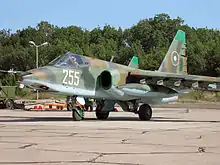
Bulgarian Air Force Su-25 in Bezmer Air Base 2013
.jpeg.webp)
Chad Air Force Su-25 at N'djamena Airport
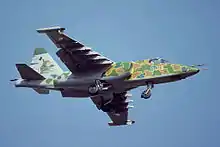
Czechoslovak Air Force Sukhoi Su-25K at Royal International Air Tattoo 1992

Kazakhstan Air Force Su-25
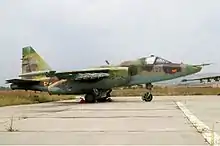
Macedonian Air Force Sukhoi Su-25
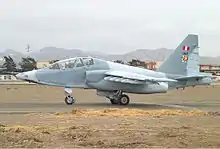
Peruvian Air Force Su-25
.jpg.webp)
Russian Air Force Su-25SM
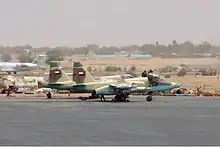
Sudanese Air Force Sukhoi Su-25s
.jpg.webp)
Turkmenistan Su-25UB
_in_background.jpg.webp)
Ukrainian Su-25UB
 Angola
Angola- People's Air and Air Defence Force of Angola. An agreement was reached at the beginning of 1988 between the Soviet Union and Angola that arranged for the delivery of a squadron of Su-25s. The Angolan export agreement comprised 12 single-seat Su-25Ks and two Su-25UBKs trainers. Later, these aircraft were augmented by further deliveries comprising at least three two-seater aircraft.[1]
 Armenia
Armenia- Armenian Air Force. Following the break-up of the Soviet Union, Armenia had no Su-25s in its inventory, but following the start of the war in Nagorno-Karabakh in 1991–92, the newly independent Armenia unofficially acquired a small number of aircraft, including one new Su-25K that was stolen from the Georgian Air Force on 15 November 1993 by Georgian Captain Sergey Zhitnikov and flown to Armenia.[2] It operates 5 Su-25, 9 Su-25K and 1 Su-25UBK as of January 2009.[3]
 Azerbaijan
Azerbaijan- Azerbaijan Air Force. Like Armenia, Azerbaijan did not inherit any Su-25s after the collapse of the USSR, but a single aircraft was obtained in April 1992 as a consequence of a pilot defecting from the Russian Air Force base at Sital-Chai. Following the incident, Azerbaijan acquired at least five Su-25s through unofficial channels, and one more aircraft has been obtained as the result of yet another defection, this time from the Georgian Air Force. Other aircraft are believed to have been acquired later, as a 2001 inventory of Azerbaijan aircraft revealed that the Azerbaijan Air Force had three of the type in its inventory, after the reported loss of four Su-25s in combat operations relating to the disputed Nagorno-Karabakh region.[1]
 Belarus
Belarus- Belarus Air Force. After the break-up of the Soviet Union, Belarus was the second member state of the CIS, after Russia, to have a significant number of Su-25s. Seventy Su-25s and six Su-25UBs are reported to be operational and are mostly concentrated at Lida air base by 2004.[4]
 Bulgaria
Bulgaria- Bulgarian Air Force. Bulgaria was the second Warsaw Pact country to obtain the Su-25, acquiring its first examples of both Su-25K and the Su-25UBK in 1985. The aircraft were intended to replace the obsolete MiG-17F Fresco-C which had been the backbone of the Bulgarian Air Force fighter-bomber fleet for many years. Twenty Su-25Ks and three Su-25UBKs were commissioned and were operational at Bezmer Air Base by 2004.[4][5][6][7]
 Chad
Chad- Chadian Air Force acquired a total of six aircraft (4 Su-25 and 2 Su-25UB) from Ukraine in 2008.[8]
 Democratic Republic of the Congo
Democratic Republic of the Congo- Air Force of the Democratic Republic of the Congo. In late 1999, the Tbilisi Aerospace Manufacturing plant signed a contract with the Democratic Republic of Congo for the delivery of 10 Su-25Ks to the Force Aerienne Congolaise. The deal was reported to be valued at 6 million US Dollars, and the first four aircraft were delivered on board an An-124 in November 1999. The remaining six aircraft were delivered in January 2000.[4] One aircraft crashed in December 2006 during a routine flight, while another one crashed on 30 June 2007, during a Congolese independence day display.[9]
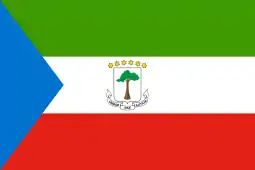 Equatorial Guinea
Equatorial Guinea- In 2005, 4 Su 25s including 2 Su-25UB combat trainers were delivered to the Equatorial Guinea Air Corps. The current status of the aircraft is unknown.[10]
 Ethiopia
Ethiopia- Ethiopian Air Force. A pair of Su-25Ts and two Su-25UBK combat trainers were delivered to Ethiopia in the first quarter of 2000. The twin-seaters were withdrawn from Russian Air Force service and modified in accordance to a special request by the Ethiopian Air Force. Since acquiring the aircraft, the Ethiopians have used them in combat operations against Eritrean insurgent groups.[4]
 Georgia
Georgia- Georgian Air Force. Georgia, home to Tbilisi Aircraft Manufacturing which produced scores of single-seat Su-25s during the Soviet era, was left with virtually no aircraft following the break-up of the Soviet Union. Only a small number of single-seat Su-25s were actually brought into the inventory of the newly formed Georgian Air Force (now army air force), these aircraft having been left in the factory at the time of Georgian independence. Georgia had nine Su-25s of different variants, with eight of them being Su-25KM "Scorpion"s (an upgraded variants of the Su-25 in collaboration with Israel) as of 2004.[11]
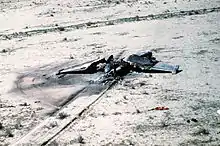 An Iraqi Su-25 destroyed during Operation Desert Storm
An Iraqi Su-25 destroyed during Operation Desert Storm
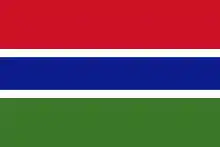 Gambia
Gambia- Gambian Army – operates one Su-25 as of 2008.[12][13]
 Iran
Iran- Islamic Revolutionary Guards Corps Air Force. On 21 January 1991, seven Iraqi Su-25s were flown to Iran in an effort to find a temporary safe haven from Operation Desert Storm attacks on major Iraqi airfields. These aircraft were considered by Iran to be a gift from its former adversary, and were seized by the Iranian military. However, as a result of a lack of spare parts, documentation, and pilot training, these aircraft were not flown by the Islamic Republic of Iran Air Force. Iran has added at least six new examples to its inventory and has since likely restored ex-Iraqi Su-25s to flight status as well.[14] Reports indicate that some of the IRGCAF aircraft have been transferred back to Iraq in July 2014, to increase the latter's CAS and COIN capabilities.[15]
 Iraq
Iraq- Iraqi Air Force. During the course of the early phase of the Iran–Iraq War, Iraq approached the Soviet Union with a request to purchase a wide variety of military equipment. As a result, Iraq became the first, non-Warsaw Pact country to obtain the Su-25K and Su-25UBK combat trainer. It is believed that Iraq received a total of 73 examples, of which four were Su-25UBKs. In January 1998, the Iraqi Air Force still possessed 12 Su-25s, and at least three Su-25Ks were seen in a demonstration over Baghdad in December 2002. However, the remaining Su-25s were phased out immediately after the 2003 Invasion of Iraq.[4] In 2014, the IQAF signed a deal with Russia and Belarus for the purchase of more examples, with the first five arriving on 28 June 2014.[16] Reports indicate that a further seven were delivered from Iran on 1 July 2014, all of which were ex-Iraqi examples from the 1991 Gulf War.[15]
 Ivory Coast
Ivory Coast- Air Force of Ivory Coast. In November 2004, nine French soldiers were killed and 23 wounded when two Ivorian Su-25s bombed French positions in Bouaké.[17] As a result, French soldiers destroyed the Su-25s on the ground at Yamoussoukro air base.[18]
 Kazakhstan
Kazakhstan- Kazakh Air Force – received 12 single-seat Su-25s and two Su-25UB trainers in December 1995 as compensatory payment for the return of the Tu-95MS "Bear-H" strategic bombers which had been rapidly flown out of the republic at the time of the collapse of the USSR. The Kazakh Su-25s are located at Chimkent air base in the south of the country.[4]
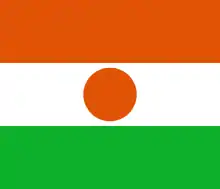 Niger
Niger- Niger Air Force – operated two SU-25s in 2014.[19]
 North Korea
North Korea- North Korean Air Force – North Korea was the first Asian country to obtain the Su-25. In the 1950s, the North Korean Air Force had accumulated experience operating the Su-25's piston-engined predecessor, the Ilyushin Il-10 "Beast". In the period from the end of 1987 until 1989, the DPRK acquired a total of 32 single-seat Su-25Ks and four Su-25UBKs. The aircraft are based at Sunchon Airport (20 km from Pyongyang), which features heavily fortified natural hangars equipped with blast-proof doors capable of protecting the aircraft from conventional and nuclear explosions.[20]
 Peru
Peru- Peruvian Air Force. Peru received 18 Su-25s in late 1998 from Belarus, which refurbished them prior to delivery. Their acquisition came at a time of tensions with neighboring Ecuador, in the aftermath of the 1995 Cenepa War. The shipment comprised 10 single-seat and eight dual-seat Su-25UB trainers. The aircraft were all built just before the collapse of the Soviet Union and thus represented the final versions of the Soviet Su-25. It is believed that between 1998 and December 2005, at least 25 light aircraft transporting cocaine had been shot down by the Peruvian Su-25s.[20] As of February 2013, 18 Su-25s are in service, with only 4 aircraft operational.[21]
 Russia
Russia- Russian Air Force – Russia possesses a reduced fleet of Su-25s, which are operated by Attack Regiments. The major variants used are the single-seat Su-25, the twin-seat Su-25UB, and the Su-25BM target-towing version. In addition, the Russian Air Force received a small number of the Su-25T anti-tank variant, which have been tested under combat conditions in Chechnya. Overall, 286 Su-25s are in service with the Russian Air Force as of 2008.[22] A modernisation programme of single-seat Su-25s to the Su-25SM variant is underway.[20] The first, modernised Su-25SM was delivered in August 2001.[23] By March 2013, over 60 Su-25SMs were scheduled to be delivered. The modernisation programme is to conclude in 2020 with over 80 examples upgraded.[24]
- Russian Naval Aviation – the Russian Navy operates an adapted version of the Su-25UB two-seat trainer, the Su-25UTG. This is a carrier capable version used to carrier out full deck-landing training aboard the Navy's aircraft carrier.
 Sudan
Sudan- Sudanese Air Force – had one Su-25 in service as of November 2008.[13] Since 2008 it has reportedly obtained 15 aircraft from Belarus.[25]
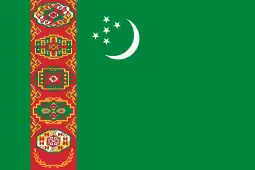 Turkmenistan
Turkmenistan- Turkmenistan Air Force – Following the downfall of the Soviet Union, the newly independent Republic of Turkmenistan was given 46 Su-25s which had been disassembled for storage in Turkmenistan at that time. In accordance with an agreement between Georgia and Turkmenistan in 1999, the Tbilisi Aerospace Manufacturing corporation refurbished 45 of these aircraft for use by the Turkmenistan Air Force as payment for the delivery of natural gas. The refurbished aircraft were relocated at Ak-Tepe air base, and a total of 18 operational Su-25s are known to be based there by 2004.[20]
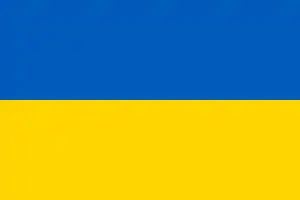 Ukraine
Ukraine- Ukrainian Air Force. Ukraine obtained 92 Su-25s of differing variants following the country's independence in the wake of the break-up of the USSR. Currently, the Ukrainian Air Force operates approximately 60 Su-25, Su-25UBs, and Su-25UTGs, which are operated by the 299th Independent Assault Regiment (299 OShAP) based at Kulbakino, Mykolaiv Oblast, and at the 456th Assault Regiment (456 ShAP) at Chortkiv. Up to 30 Su-25s are reportedly stored at the 4070th Reserve Base. Evidently, three Su-25s sold to Macedonia came from this reserve pool.[20] Also, Ukrainian Air Force modernized two types of the Su-25, one of them is Su-25M1 and Su-25UBM1.[26] Ukrainian Naval Aviation. Former operator.
 Uzbekistan
Uzbekistan- Until 1990, a Soviet Air Force pilot training centre equipped with around 20 Su-25, Su-25UB, and Su-25BM variants was located at Chirchik air base in Uzbekistan. In 1991, a small number of Su-25s were also located at Dzhizak air base, but after 1991, all Su-25s in Uzbekistan were concentrated at Chirchik, operated by the 59th Fighter-Bomber Aviation Regiment (59 APIB) of the Soviet Air Force. After the collapse of the Soviet Union, all the Su-25s on the territory of the now independent republic became the property of the new government.[20]
Former operators
 Czechoslovakia
Czechoslovakia- Czechoslovakian Air Force. Passed aircraft on to successor states, in the ratio of 2:1 in favour of the Czech Republic.[4]
 Czech Republic
Czech Republic- Czech Air Force. After the dissolution of Czechoslovakia, the Czech Republic acquired twenty-four Su-25Ks and one Su-25UBK. In December 2000, the Czech Su-25s were retired from service and placed in storage at Přerov air base.[27]
 North Macedonia
North Macedonia- Macedonian Air Force. The Republic of Macedonia purchased three single-seat Su-25s and one Su-25UB following incursions and attacks by Albanian insurgents. The aircraft were supplied by Ukrainian authorities after having been withdrawn from Ukrainian Air Force service.[28] The aircraft were retired in 2004, and reportedly sold to Georgia in 2005.[29]
 Slovakia
Slovakia- The Slovak Air Force received 12 Su-25Ks and one Su-25UBK following the dissolution of Czechoslovakia. The aircraft were based at the Slovak 33rd Air Base in Malacky-Kuchyna. They were sold to Armenia.[4]
- The Somali Air Force had an Unknown number of Su-25's. The wreck of one can be seen at a Somali Air Force boneyard.[30]
- Soviet Air Force. Passed aircraft on to successor states.
Unrecognised operators
![]() Novorossiya - 1 plane in Luhansk state aviation museum
Novorossiya - 1 plane in Luhansk state aviation museum
- Artsakh Defense Army aviation
References
- Gordon and Dawes 2004, pp. 89–92.
- "History of the Air Forces of Georgia". Geo-army.ge. Retrieved 12 September 2013.
- "World Military Aircraft Inventory". Aerospace Source Book 2009. Aviation Week & Space Technology, 26 January 2009.
- Gordon and Dawes 2004, pp. 93–96.
- "Restore the airworthiness of the Su-25 and Bell-206". Retrieved 19 February 2014.
- "Repair airbase Bezmer. Su25 in airbase Graf Ignatievo to 2015 when Su25 return in airbase Bezmer".
- "Weapons and military equipment".
- "Chadian Air Force/" Archived 2008-12-27 at the Wayback MachineMilAvia Press.com. Retrieved: 26 January 2012.
- ""Congolese fighter jet crashes during display."". Archived from the original on 9 December 2008. Retrieved 20 March 2012. Reuters, 30 June 2007. Retrieved: 17 June 2008.
- "Equatorial Guinea National Guard". Scramble.nl. Retrieved: 3 January 2009. Archived 21 October 2008 at the Wayback Machine
- Gordon and Dawes 2004, p. 97.
- "World Military Aircraft Inventory", 2007 Aerospace Source Book. Aviation Week & Space Technology, 15 January 2007.
- "Directory: World Air Forces". Flight International, 11–17 November 2008.
- ""Iran bolsters Su-25 fleet"". Archived from the original on 8 October 2007. Retrieved 10 February 2013.CS1 maint: bot: original URL status unknown (link). Jane's Defence Weekly, 13 September 2006.
- Jonathan Marcus (2 Jul 2014), 'Iranian attack jets deployed' to help Iraq fight Isis, BBC News, retrieved 2 July 2014
- Russian fighter jets arrive in Iraq for fight against rebels, Haaretz, 29 Jun 2014, retrieved 29 Jun 2014
- "Nine French soldiers killed in Cote d'Ivoire." People's Daily Online, 8 November 2004.
- "France attacks Ivorian airbase." BBC News, 6 November 2004.
- "Niger Risk Assessment 2014" (PDF). syr.edu. Retrieved 3 February 2018.
- Gordon and Dawes 2004, pp. 100–102.
- Spain offers Eurofighters to Peru – Flightglobal.com, 4 February 2013
- "Russian Military Analysis on Su-25". warfare.ru. Retrieved: 18 June 2007.
- "Force report: Russian Air Force." Air Forces Monthly, July 2007, pp. 78–86.
- "Russia to Field New Ground Attack Jet." RIA Novosti. Retrieved: 17 June 2012. Archived 20 May 2012 at the Wayback Machine
- "Disputed attack jets seen by U.N. envoys in Darfur." reuters.com.
- "Su-25." ukrinform.ua. Retrieved: 3 August 2010.
- "Czech Su-25s.", Scramble (magazine). Retrieved 26 July 2011. Archived 10 February 2007 at the Wayback Machine
- Gordon and Dawes 2004, p. 99.
- "Macedonian Air Force, Aircraft Types, Su-25." aeroflight.co.uk, 15 September 2005.
- "Les épaves... d'avion - Page : 6 - Photos - Salon de discussion - FORUM Les clubs". www.forum-auto.com (in French). Retrieved 2018-07-02.
- ""Novorossiya Air Force" strikes Ukraine for first time". politicalhotwire.com. Retrieved 2018-05-27.
This article is issued from Wikipedia. The text is licensed under Creative Commons - Attribution - Sharealike. Additional terms may apply for the media files.